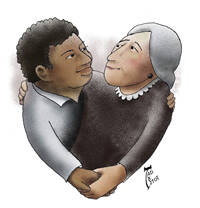It's Complicated
Catholics understand revelation as arising from a single source and manifesting itself through both Scripture and tradition. That is, the Bible and the dynamic, Spirit-filled life of the church become a mutually informing expression of God’s guidance. As Scripture molds how tradition views the world, tradition, ever evolving to changing conditions, brings different questions and perspectives to Scripture.
In today’s Gospel reading, Jesus is tested by the Pharisees about Moses’ allowance for divorce. Jesus appears to articulate an absolute rule: no divorce, or at least no divorce and remarriage. Early on the church struggled with such an absolute pronouncement. We see the struggle even within the New Testament itself. Matthew’s version of the same story (19:9) adds an exception Jesus appears not to have made originally, for sexual immorality (porneia). Paul refers to Jesus’ original teaching (1 Cor 7:10) and apparently feels free to nuance it to fit the conditions of the church. In this case Paul allowed divorce and remarriage between believer and unbeliever if the unbeliever wished it. The value he draws upon is God’s will that we live in peace (7:15).
Today, the Catholic Church takes the indissolubility of marriage as a divine law, but then allows annulments for various reasons, including the very vague “lack of due discretion.” These ongoing considerations reflect efforts to take the teachings of Jesus seriously in a complex world.
It might be helpful to consider how Jesus responded to the Pharisees. He took them out of their legal mentality and into the divine vision of the very nature of the human condition and the profound relationship God intends husbands and wives to have. He drew them back to Genesis, our first reading, and to Adam, God’s lonely gardener. Being alone is not right, so God creates all the animals; but they are no partners for the man. God then takes a rib from Adam and forms Eve.
If we reflect on the symbolism, Adam not only finds “bone of my bone, flesh of my flesh”; he is also missing a rib. Eve has it. To be complete he needs to reconnect with that rib. “That is why a man leaves his father and mother and clings to his wife, and the two of them become one body.” This is the purpose of marriage: the giving of oneself over to this new creation.
So divorce is clearly contrary to what we were made for in terms of marriage. This is the teaching of the Lord. No one knows this truth more deeply than earnest believers who committed their lives to a union that is now fractured by divorce. Their pain, loneliness, sense of failure and often even shame speak loudly and clearly that this brokenness is not the flourishing God intended. Does that make them violators of the divine law? Adulterers in a remarriage? Not necessarily. Like Matthew, Paul and the modern church, one is wise to take both Jesus’ words and the dynamic tradition to heart, and use both to wrestle with this complex moral problem. One thing should be obvious: when we do such wrestling, we should always be sensitive to everyone’s pain and the priority of conscience. The second reading, from the Letter to the Hebrews, describes Jesus’ solidarity with us as a consequence of his own suffering. Our solidarity involves entering into each other’s brokenness as well.
Pope Benedict XVI spoke early in his pontificate to pastors about Catholics who divorced and remarried without an annulment. “None of us has a ready-made solution,” he said; “each person’s suffering is different.” He even saw their presence at the Eucharist as “involvement in the mystery of the Cross and resurrection of Christ. Given that it is the sacrament of the passion of Christ, the suffering Christ embraces these persons in a special way.... They can feel embraced by the crucified Lord who falls to the earth and dies and suffers for them and with them”—and with us all.
This article also appeared in print, under the headline “It's Complicated,” in the October 1, 2012, issue.








